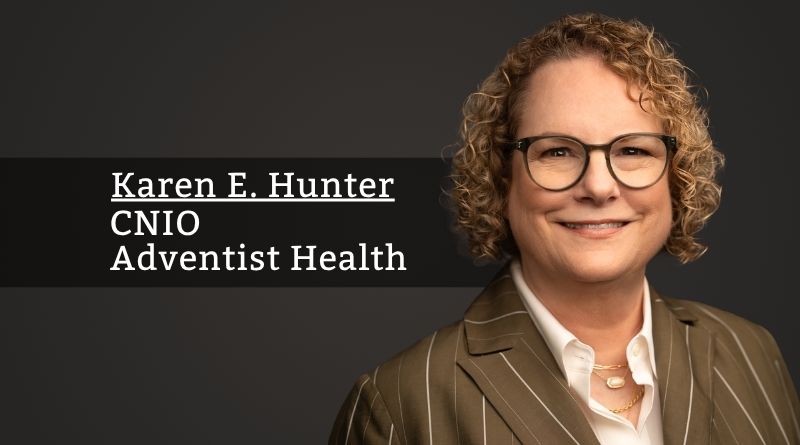The First Five Minutes: AI’s Edge in Emergency Care
By Karen E. Hunter, CNIO, Adventist Health
The promise of artificial intelligence (AI) in healthcare is significant. In emergency departments, it’s enormous. But at our organization, we weren’t looking for hype. We were looking for help. Specifically, help for our nurses.
Emergency triage is where care begins—and where the earliest clinical decisions set the course for everything that follows: testing, treatments, resources, and ultimately, costs. Those decisions are almost always made by nurses.
The excitement was palpable when we first implemented a clinical decision support (CDS) tool powered by AI to assist with triage accuracy and early risk detection. There was tremendous hype; every emergency department (ED) wanted it. So we installed it systemwide.
Staffing isn’t just about headcount. It’s about clarity. When nurses spend less time chasing information and more time acting on it, we extend their reach without stretching them thin.
In the years that followed, some sites embraced it and squeezed real value out of it. Others did not. When current financial challenges emerged, the tool began to be viewed by some as a “nice-to-have” rather than a core asset. It was offered up as a potential cost-saving cut.
That’s when we started asking tougher questions: Was there measurable value? Who was actually using it? And how did it affect clinical and financial outcomes? That investigation began nine months ago.
The Skepticism Phase: AI Has to Earn Its Place
From day one, we took a cautious, data-driven approach. We asked: What does this tool actually do? How does it change nurse behavior? Does it save time, reduce friction, or lead to better outcomes? If it doesn’t, it’s not worth using—even if it’s “cutting-edge.”
The tool had been deployed for several years and we saw two radically different adoption patterns. In some units, the tool became essential: “When it speaks, we listen,” one leader told us. In others, it was ignored. “We don’t use it. We have doctors in triage,” came the feedback.
Rather than enforce usage, we decided to measure impact.
The Metrics Phase: Where the Value Showed Up
Over the course of nine months, we evaluated the tool using both qualitative feedback and quantitative metrics. What we found surprised even our skeptics:
• A measurable decrease in time from triage to disposition decision
• A rise in charge capture and ED revenue in high-use sites
• Sepsis recognition doubled where the tool was in active use
• Downstream impact: a correlating reduction in inpatient length of stay (LOS)
One of the most important insights? Nurses were using the AI’s recommendations not as orders, but as conversation starters. It helped newer nurses build confidence and gave experienced nurses a second set of eyes.
The Divide: What Drives Success?
Why did some sites embrace it while others resisted? It wasn’t the tool. It was leadership.
The most successful teams didn’t just install the AI. They monitored its performance, reviewed dashboard data twice daily, and built clinical protocols around its alerts. In contrast, lower-engagement sites treated it as optional background noise and that’s what it became.
The lesson? AI tools only work when leaders commit to integrating them into clinical culture. Staff follow cues. Technology doesn’t drive behavior—people do.
The Real Lesson: Efficiency Is a Staffing Strategy
This wasn’t a story about technology for technology’s sake. It became a story about how smarter tools support better staffing.
We didn’t add more nurses to the floor. Instead, we reduced cognitive load, made clinical patterns more visible, and supported faster decision-making. In the chaos of emergency triage, that’s not a minor upgrade—it’s a survival mechanism.
Staffing isn’t just about headcount. It’s about clarity. When nurses spend less time chasing information and more time acting on it, we extend their reach without stretching them thin.
When triage is more accurate from the start, patients move faster, care plans are more appropriate, and costly delays are reduced. That’s how nursing impacts the total cost of care—quietly, constantly, and often without recognition.
What Comes Next: From Pilot to Practice
Some sites are still skeptical. Some are considering deactivating the tool altogether. That’s okay. We welcome scrutiny. We built our confidence in this solution not on belief, but on data.
Looking ahead, the tool is evolving to cover more use cases—including better risk prediction in pediatric patients, more accurate triage for EMS handoffs, and enhanced insight reporting for operational planning. A risk dashboard will offer early predictions for disposition, ICU admission, and short-term mortality. Continuous sepsis monitoring has also shown promising early results.
Our approach remains the same: stay grounded in frontline realities, ask tough questions, and measure what matters.
Conclusion: The First Clinician
Triage nurses are often the first and fastest clinicians a patient sees. Their decisions create the blueprint for everything that follows. Supporting them isn’t optional—it’s foundational.
If we want to talk seriously about controlling the cost of care, we have to talk about the accuracy, consistency, and support behind those first decisions. That’s where AI has earned its place in our strategy.
Not because it’s new. But because it helped us see just how valuable our nurses already are.



